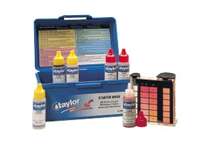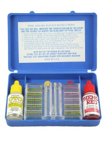Many aquatic professionals are intimidated by the complexity of pool water chemistry when in reality, it is not as complicated as it may seem.
If water is cloudy, there is a serious problem, but clear water doesn’t necessarily mean safe water either. Every pool that is open for public use has to be tested at least 3 times a day and results of those tests need to be recorded in a written log. This is the law, according to public health codes.
The 3 main tests are:
- pH
- Free Chlorine
- Total or combined Chlorine
Safe Level of Combined Chlorine
There are different opinions on “safe levels” of combined chlorine (chloramines) in pool water.

Our opinion is that if there is a perceptible change in the color when the 3 drops are added (Taylor Test kit above), you have a problem.
Chloramine formation can be accelerated by:
- Pool users not properly showering before entering the pool.
- People using the pool rather than getting out and going to the restroom.
- People sweating. Everyone sweats in the water – just like you would exercising on land.
- Residues from ammonia or nitrogen-based cleaning products used to clean the deck/showers.
- Fertilizer residues tracked on shoes into the building (nitrogen-based used on landscaping).
- Poor air circulation and lack of fresh air introduction into the pool building.
- Over-use of “shocking” the pool for maintenance purposes. The pool should not be shocked before or during meets. In fact, current research shows using a chlorine-based shock should only happen if there is an identifiable bacteria problem.
- Operating the pool with too high of free chlorine level. Anything over 2.5 ppm is a waste of chlorine ($) and can cause water chemistry issues.
- Improper use of chemical brands not suitable for conditions specific to a geographic area.
- The source water (city water) being treated with chloramines rather than chlorine. This is becoming more prevalent. This is a database that may help you find out if your city uses chloramines: http://www.bulkreefsupply.com/chloramines-database
Solutions for Cloudy Pool Water and Prevention
Almost always more than one thing needs to be changed to alleviate the problem. Successful solutions working hand-in-hand are:
- Having staff attempt to get the users of the pool to shower before entering – this is usually required by state health codes, but for some reason, people have started ignoring the codes. They are there for a really good reason. Minimum 15 second warm shower, including hair.
- Educating instructors – swimmers – pool staff – that it is not only unsanitary to pee in the pool, but that it can quickly affect water chemistry. Research shows one person peeing in the pool can adversely affect 10,000 gallons of pool water for 9 days.
- Considering installing a medium pressure Ultra Violet (UV) water treatment system in indoor pools that cuts down on the amount of chlorine you have to use and also “breaks down” mono and di and tri-chloramines.
- Evaluating the type and brands of chemicals being used to treat the pool water for both chlorine and pH control – there are a lot of “gimmicky” chemicals sold that do more harm than good.
- Evaluating the pool filtration system to see if a filter that filters down to a more effective micron rating (like DE at 3 microns) would help.
- Checking the labels on all cleaning products to make sure they do not contain ammonia or are not nitrogen enriched.
- Making sure the pool is not being shocked on a regular schedule just because someone thought it was the best thing to do.
- If the source water has chloramines, install and activate a carbon filter on the pool fresh water fill line. This will remove chloramines. Outdoor pool may not need to do this because the sun’s natural UV destroys chloramines.
- Evaluating the air circulation system (indoor pools) and possibly including more fresh air introduction and better turnover or more efficient closed system circulation and dehumidification.
Things to consider:
- The amount of fresh air that is being introduced into the building every hour. This is totally dependent on outdoor climate and type of building. A 90% change of air every 20-25 minutes works well in warm areas.
- The condition of the air-handling equipment filters. The filters should be cleaned or changed every 3 months. There are micro-filters that filter out more air-borne contaminates than the standard fiberglass or paper filters.
- The type of air-handling system you have, and is it regularly serviced and working properly? Routine maintenance must be done and tracked on all pieces of air-handling equipment. Vents and louvers must be checked and lubed at least 4 times a year to make sure they are working properly. Dust must be removed from the surface of vents. Motor belts and fuses also need to be checked.
- The air flow across the surface of pool and the amount of air being exhausted from the pool room. If the sizing of the HVAC system or the duct design was not engineered correctly, there are retrofits and new technologies that can help correct the under-design of the original equipment. These are stand alone units with air flow in gutters, drains or benches.
 Every aquatic professional should know how to do a basic water test and what the results mean. A 2-part test kit (under $10) can be purchased at most big-box stores. They are not much bigger than a sunglasses case and can fit in a purse, bag or pants pocket. They test for pH and free CL. Test strips are not as accurate, but may serve your purpose
Every aquatic professional should know how to do a basic water test and what the results mean. A 2-part test kit (under $10) can be purchased at most big-box stores. They are not much bigger than a sunglasses case and can fit in a purse, bag or pants pocket. They test for pH and free CL. Test strips are not as accurate, but may serve your purpose
Risks of Cloudy Pool Water
- If the CL is over 3.0 ppm, you can get dry skin, bleached out swim apparel and chlorine odors. If the CL is under .05 ppm, bacteria can thrive, and the water may not be safe.
- If the pH is under 7.2, you can get skin rashes, yellowing of tooth enamel and fingernail issues.
- If the pH is over 7.5, you can have burning eyes, chlorine odors, discolored pool water, and the chlorine may not be disinfecting properly.
- Algae can also grow in a high pH pool.
- The best pool is 7.4 pH and CL between 1.8 and 2.5 ppm.
- If water is cloudy and the chemical readings are normal, there is probably a pool filter problem.
- NEVER GET IN A CLOUDY POOL. Report it to the pool management.
For more detailed information, please email Mick Nelson at mnelson@usaswimming.org.
Written by Mick Nelson
 Mick Nelson has a coaching career of 30+ years, and specializes in business development, programming, water treatment and aquatic facility design with USA Swimming, whose Facilities Development Department has been instrumental in many projects involving air and water quality challenges and pool renovations. There are currently 35 new pool design projects in the planning stages and 18 new pool openings slated.
Mick Nelson has a coaching career of 30+ years, and specializes in business development, programming, water treatment and aquatic facility design with USA Swimming, whose Facilities Development Department has been instrumental in many projects involving air and water quality challenges and pool renovations. There are currently 35 new pool design projects in the planning stages and 18 new pool openings slated.
